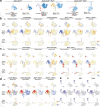Uncovering minimal pathways in melanoma initiation
- PMID: 40571713
- PMCID: PMC12202705
- DOI: 10.1038/s41467-025-60742-0
Uncovering minimal pathways in melanoma initiation
Abstract
Melanomas are genetically heterogeneous, displaying mitogen-activated protein kinase mutations and homozygous loss of tumor suppressor genes. Mouse models combining such mutations produce fast-growing tumors. In contrast, rare, slow-growing tumors arise in mice combining Braf activation with heterozygous loss of Pten. Here we show that similar tumors can arise in albino mice bearing only a Braf mutation. Incidence kinetics suggest a stochastic event underlies tumorigenesis in tumors that arise with only a Braf mutation, yet de novo mutations or structural variants that could explain the incidence of most tumors could not be found. Single-cell transcriptomics of tumors identify a cell type resembling "neural crest-like" cells in human and mouse melanomas. These exist in normal mouse skin, expand upon Braf activation, and persist through serial transplantation; analyses of gene expression suggest they serve as precursors of malignant cells. This state may serve as an intermediate on a slow path to malignancy that may provide a diagnostically and therapeutically important source of cellular heterogeneity.
© 2025. The Author(s).
Conflict of interest statement
Competing interests: The authors declare no competing interests.
Figures






Update of
-
Uncovering Minimal Pathways in Melanoma Initiation.bioRxiv [Preprint]. 2024 Jan 9:2023.12.08.570336. doi: 10.1101/2023.12.08.570336. bioRxiv. 2024. Update in: Nat Commun. 2025 Jun 26;16(1):5369. doi: 10.1038/s41467-025-60742-0. PMID: 38106189 Free PMC article. Updated. Preprint.
References
-
- Hayward, N. K. et al. Whole-genome landscapes of major melanoma subtypes. Nature545, 175–180 (2017). - PubMed
-
- Shain, A. H. et al. The genetic evolution of melanoma from precursor lesions. N. Engl. J. Med.373, 1926–1936 (2015). - PubMed
-
- Davies, H. et al. Mutations of the BRAF gene in human cancer. Nature417, 949–954 (2002). - PubMed
MeSH terms
Substances
Grants and funding
LinkOut - more resources
Full Text Sources
Medical
Molecular Biology Databases
Research Materials

